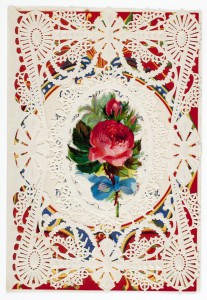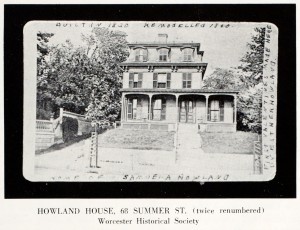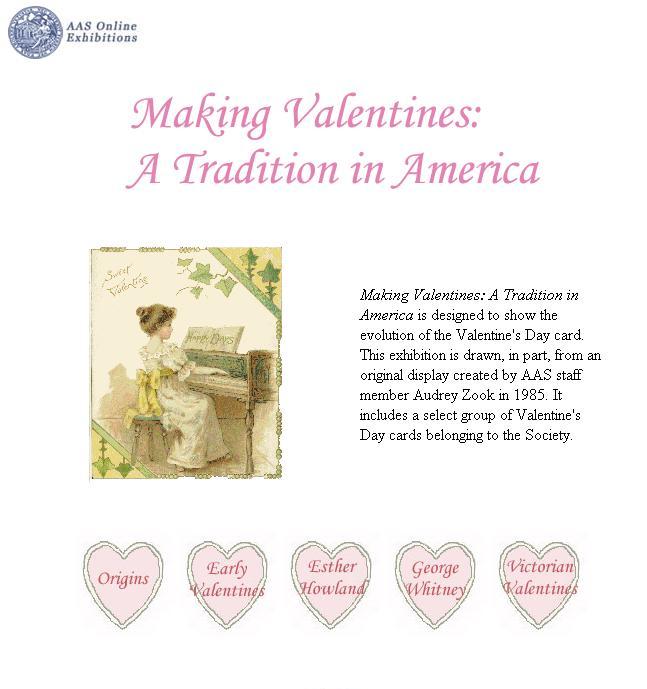 Did you know that the American valentine industry started right here in Worcester in 1848? That America’s first widely mass-produced valentines were designed by a woman named Esther Howland in her workshop on Summer Street? That Victorians ate conversation hearts? That Valentine’s Day greetings were part of a larger cultural debate in early America about love’s relationship to marriage? The American Antiquarian Society has much to teach us by way of Valentine’s Day lore. Among its collections are valentines designed by Esther Howland and secondary source material on the history of valentines in America.
Did you know that the American valentine industry started right here in Worcester in 1848? That America’s first widely mass-produced valentines were designed by a woman named Esther Howland in her workshop on Summer Street? That Victorians ate conversation hearts? That Valentine’s Day greetings were part of a larger cultural debate in early America about love’s relationship to marriage? The American Antiquarian Society has much to teach us by way of Valentine’s Day lore. Among its collections are valentines designed by Esther Howland and secondary source material on the history of valentines in America.
Esther Howland (1828-1904), a Mount Holyoke grad and Summer Street native, produced America’s first elaborate valentines here in Worcester in 1848, the same year that Worcester became a city.  The daughter of an affluent stationer, Howland first copied a Valentine’s Day greeting sent from England by her father’s colleague. An astute businesswoman, Howland eventually opened a successful female-run valentine business combining the female world of the hearth and home with the world of commerce, at a time when valentines were becoming increasingly popular. She became known as the “Mother of the Valentine.” Though never marrying herself, Howland united innumerable lovers through her valentines.
The daughter of an affluent stationer, Howland first copied a Valentine’s Day greeting sent from England by her father’s colleague. An astute businesswoman, Howland eventually opened a successful female-run valentine business combining the female world of the hearth and home with the world of commerce, at a time when valentines were becoming increasingly popular. She became known as the “Mother of the Valentine.” Though never marrying herself, Howland united innumerable lovers through her valentines.
Exchanging valentines had become very popular in America by the early 1840s. In 1846 over 30,000 valentines passed through the New York City post-office on the 14th. In a February 14, 1849 letter to her cousin, Emily Dickinson commented on the widespread nature of the Victorian valentine craze:
The last week has been a merry one in Amherst, & notes have flown around like, snowflakes. Ancient gentlemen, & spinsters, forgetting time, & multitude of years, have doffed their wrinkles – in exchange for smiles – even this aged world of our’s, has thrown away it’s staff – and spectacles, & now declares it will be young again. (quoted in Petrino 89)
Valentines were scrutinized to determine lovers’ feelings and sometimes resulted in offers of marriage. In fact, Susan Sweeney notes that even “the position of the stamp could reveal a sender’s feelings: upside down meant “I’m lovesick”; sideways, pointing right, meant “love and kisses”; sideways, pointing left, meant “I’ll never leave you”; diagonal, pointing right, meant “Will you marry me?”; and diagonal, pointing left, meant “Yes, I will.” (Sweeney 78) Lovers lacking verbal facility could copy verses from valentine writers, small books suggesting various poems tailored to suit the many moods writers might wish to convey (Sweeney 82). The American Antiquarian Society has some of these small treasures in its collections (click here to see a list of valentine writers from our online catalog).
Valentines had cultural significance in Victorian courtship rituals. Sweeney notes that valentines “enabled lovers to convey, interpret, and respond to romantic intentions… A man usually initiated the exchange by sending his beloved a token to which she replied in kind, producing a complex verbal transaction that began during the week of St. Valentine’s Day but could last well into March” (Sweeney 82). Debates about love’s relationship to marriage raged in nineteenth-century America. The valentine craze thus reflected “a shift toward widespread acceptance of romantic love, especially as a basis for marriage” (Cook 103).
In the midst of this new interest in valentines and the uncertain social status of romance, Esther Howland opened her valentine business. She started by setting up a workroom in the family home on Summer Street, staffing it with a few local girls to help fill the orders by copying her designs. According to Howland, her girls were paid “liberally” and the work was “light and pleasant” (Cook 100). Lisa Cook notes that Howland’s workshop likely resembled an English valentine workshop described by Dickens in All the Year Round:
[They are] in a long room occupied by nymphs, each one having at her elbow a pot, not of color this time, but of glue. Strewn before each girl in apparent confusion, but really in regularly-assorted heaps, lie hearts and darts and doves and bows and arrows, and rose-buds and true lovers’ knots, and torches of Hymen, and every variety of emblem appertaining to love and matrimony… Some are paper, some are silk and velvet, some tinsel and gold-leaf. (quoted in Cook 101)
 Esther Howland created many innovations in valentine design. She introduced layers of lace, wafers of colored paper placed beneath lace, three dimensional accordion effects, and a mechanical bouquet in which pulling a string moves flowers aside to reveal printed verses underneath. She insisted that verses and mottos not appear on the outer surface of a card. A shrewd businesswoman, she instructed her girls to write a red “H” on the back of her valentines to distinguish them when she encountered rivals. Her sales quickly reached $75,000 a year and she stayed in business for 30 years.
Esther Howland created many innovations in valentine design. She introduced layers of lace, wafers of colored paper placed beneath lace, three dimensional accordion effects, and a mechanical bouquet in which pulling a string moves flowers aside to reveal printed verses underneath. She insisted that verses and mottos not appear on the outer surface of a card. A shrewd businesswoman, she instructed her girls to write a red “H” on the back of her valentines to distinguish them when she encountered rivals. Her sales quickly reached $75,000 a year and she stayed in business for 30 years.
Original valentines produced by Esther Howland are part of the American Antiquarian Society’s collections. Many of them sport vivid primary colors in contrast to our modern reds and pinks. Delicately cut, gilt lace affairs featuring pictures of lovers in Victorian costume and verses reflecting Victorian ideals, they are a must see for anyone interested in the history of Valentine’s Day. And as for that other Valentine’s Day staple, conversation hearts, the small heart-shaped candies were also invented right here in Massachusetts by Daniel Chase of Boston in 1866.
This Valentine’s Day we hope you will keep a special place in your heart for Worcester, and Massachusetts generally, now that you know how integral their residents were in shaping Valentine’s Day traditions in America. As part of your Valentine’s Day celebrations, please enjoy more of the beautiful valentines from AAS collections in one of our classic online exhibits: “Making Valentines: A Tradition in America.” Consider it our valentine to you, dear Past is Present readers.
For Further Reading:
Cook, Lisa Connelly. “Esther Howland and the Business of Romance.” The Worcester Review. 23,2 (2002): 99-110.
Emerson, Marion Winslow. “The Rose Is Red” or Esther Howland’s Valentines. Newburyport, Mass.: Newburyport Press, 1953.
Petrino, Elizabeth A. “Allow me, Sir, at parting’: Sentimentality and Emotional Spectatorship in Dickinson and Poe’s Verse Valentines.” The Worcester Review. 23,2 (2002): 89-97.
Sweeney, Susan Elizabeth. “Words from the Heart in Early American Valentines.” The Worcester Review. 23,2 (2002): 81-87.


Loved the story. I had no idea that I could “doff” my wrinkles. Please ask Ms Dickinson to elaborate on the procedure.
Sadly Ms. Dickinson was unavailable for comment. If she were, I hazard she would encourage our readers to experiment to find the way that best suits them to exchange wrinkles for smiles. She may have advised something like: “Dwell in possibility,” “Find ecstasy in life,” or suggested we do as she did and find the thing that “makes my whole body so cold no fire can ever warm me” (in her case, reading a book of poetry).
Then again, given Dickinson’s penchant for brevity she may have just said, “Old age comes on suddenly,” and left it at that.
I am from Worcester and remember a few Valentines that I saw in a store in the City. Wish I had some now that I have read about Esther Howland.
Beautiful story and makes me feel so proud .